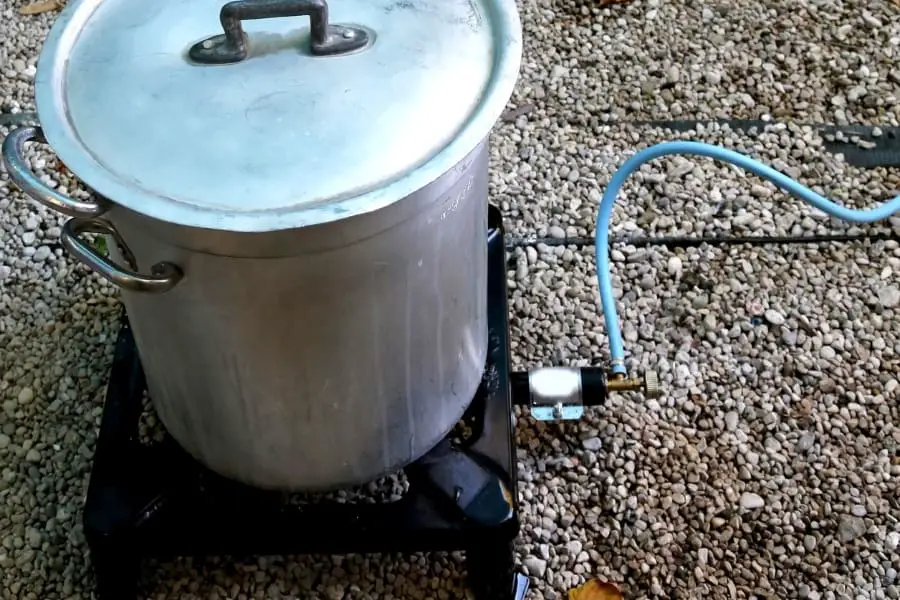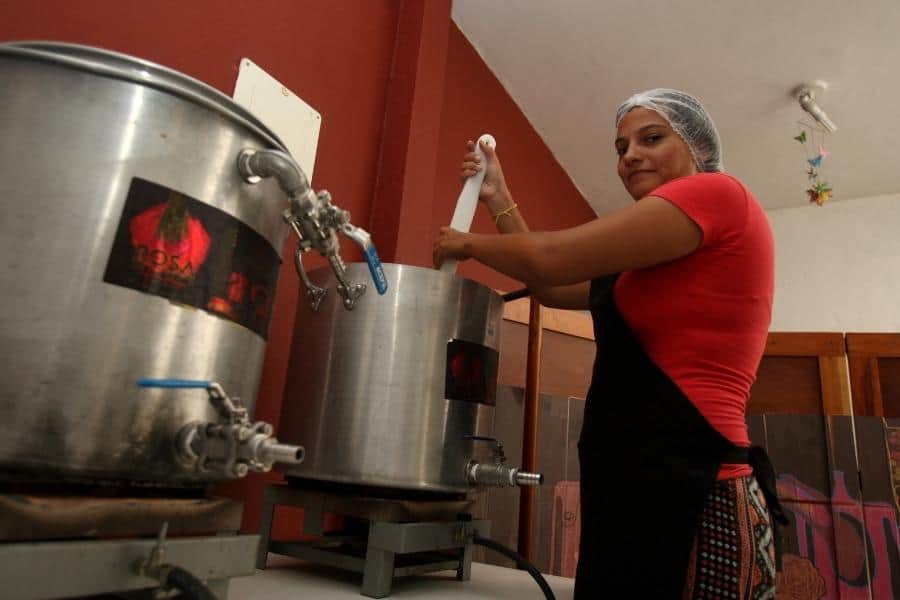If you buy something through a link in our posts, we may get a small share of the sale.
A good burner is a must-have for a successful home beer brewing experience. It may be confusing to select a good burner, especially if you don’t know what you are looking for. So let’s talk about banjo burner vs jet burner, and how to choose the best.
Contents
Banjo Burner vs Jet Burner General Overview
Buying burners can cause you a major headache. This is because they have a lot of similarities that can confuse you about which is the best one to buy. Understanding the differences between banjo burners and jet burners will help you know when to buy and use each.
Other homebrewers may confuse you further. While some will swear that their jet burner is the best, others will tell you how much it disappointed them. Therefore reading user reviews may confuse you further instead of helping you make the final choice.

It is easier to determine which suits your needs when you understand the differences between the banjo and jet burners. It is also vital to understand what appliances you need to buy if you choose the banjo burner or the jet burner.
Banjo Burner Overview
Homebrewers have been using banjo burners for years. Those who switch from other burners praise banjo burners for producing a solid flame with their pots of beer mash boiling in no time.
Additionally, there are various sizes and materials to choose from. Therefore you can choose to buy the solid and sturdy cast iron banjo burners for indoor brewing or stainless steel for outdoors. Ensure you store your banjo burners properly to avoid rusting and weakening them.
At times you may buy banjo burners that have labels and paint. First, you can heat the burner without cooking anything to burn off the paint and labels. Whatever remains will peel off the more you use your banjo burner.
Pros
- Easy to set up
- Burns silently and you can keep a conversation going as you brew
- You can grill on the side using the heat that escapes
- It is perfect for home brewers who brew a lot of beer at a go which saves gas
- It is highly adjustable, so you can adjust your flame as you brew
Cons
- It can take longer to boil than a jet burner
- If it is made of cast iron, it can rust over time
- Sensitive to the wind, so you should use it with a burner windscreen
Jet Burner Overview
In jet burners the heat is evenly distributed with a jet burner, so you don’t worry about scorching. That is why some homebrewers swear by their jet burners. Additionally, a jet burner focuses the heat on the pot; therefore, little is lost to the atmosphere.
That means your mash will boil faster, and you may even use less propane. If you are dissatisfied with the heat, you can change the regulator and always make sure you have switched the burner up.
Pros
- It is efficient, and thus it does not waste gas
- It can bring 10 gallons and below to boil very fast
- It directs the flame evenly on the pot
Cons
- Burns with a roaring sound
- Not adjustable and thus suitable if you prefer an on/off setup
Comparing Banjo Burner and Jet Burner
Many people usually find selecting between a Banjo burner and a jet burner tricky. Because both produce a lot of heat and thus they will bring your wort boiling quite fast. However, there are various similarities and differences which can help you decide which is better.

Similarities Between Banjo Burner and Jet Burner
Banjo and jet-style burners are similar in one way. When you want to buy a burner, you may be confused about which of the two you should get. Here are a few things they share:
Gas Types
You can use propane gas with a banjo burner and a jet burner. Therefore it won’t be stressful to switch from one to another because you won’t worry about getting used to different gas.
Propane burns at very high pressure, so both burners produce strong flames.
You may run out of propane at times and feel tempted to use natural gas. Never do that because propane and natural gas burn and different pressures, and thus switching one for the other is dangerous. Some burners have both setups, so consult your user manual on the same.
Durability
Both the banjo burner and jet burners are long-lasting. Whichever you buy, as long as you maintain them well, they will give you years of service. You need to follow the maintenance guidelines, and you don’t have to replace them every other month.
If any parts are worn out, you can replace them and keep enjoying your home-brewed beer. However, be careful when replacing the parts and buying from reliable dealers. If you are not careful, you may purchase low-quality parts that can easily cause accidents.
Single and Double Burners
Do you want to buy single or double burners? Whether you prefer the quiet banjo burners or the loud jet burners, you can buy either single or double burners. Therefore when you want to switch from single to double burner or vice versa for either of the two, you can.
Appliances You Need to Purchase With Both Burners
Banjo burners and jet burners need the same appliances for safety and effectiveness. Here are the appliances you need to buy with your burners:
- Regulators: You must have a propane regulator for your safety and anybody who will use your jet burner or banjo burner. You can buy 10, 20, or 30 PSI regulators, depending on your burner.
- Hose pipes: The hose pipe connects the burner to the propane tank. Although you can connect directly, a regulator is vital for safety because accidents can lead to a fire.
- Windscreen: although you may buy your jet or banjo burner for indoor brewing, at some point, you may need to take your brewing outside. A good example is when the temperature is too high or when you want to brew with friends. A windscreen will ensure your mash boils without the wind interrupting.
- Mount: if you prefer your burner to be low near the ground, you don’t have to make or purchase a stand. However, this is not comfortable for everybody, and thus if you are in this group, you can create or buy a stand. Make sure it is sturdy to support
Differences Between Banjo Burner and Jet Burner
When buying brewing burners, the differences are as significant as the similarities. Understanding how the banjo burner is different from a jet burner will help you choose the best one for you. Here are four major differences that set the two apart:

How Banjo and Jet Burners Burn
The jet burner is loud, and we mean very loud. While your beer mash is boiling on a jet burner, you cannot hold a conversation well. This may be a turn-off, especially if you regularly brew beer or invite friends over for a beer brewing get-together.
On the other hand, the Banjo burner is not as loud. Once you bring your mash to boil, you can regulate the heat, and whoever comes to your house will not know that your Banjo burner is on. You can converse with your friends or family as your mash boils!
How They Throw Heat off Your Kettle
A Banjo burner throws more heat off your kettle or pot than a jet burner. Therefore as you are boiling your beer mash using a banjo-style burner, a lot of heat may be wasted on the side. On the other hand, a jet burner throws little heat off the kettle making it more efficient.
However, you don’t have to let the heat go to waste. You can use it for various activities while waiting for the beer to cook. The combination of beer and grilled chicken, potatoes, or pork chops sounds amazing, so why not grill as the beer boils.
How They Regulate Heat
Heat regulation is an important factor, especially after adding enzyme amylase to your mash. Heat regulation is out with a jet burner because it is more on/off set. With a banjo burner, you can regulate the heat to ensure you set the temperature where enzymes are hyperactive.
Additionally, once your wort boils, having a high temperature is a waste of gas because it does not raise the temperature of the wort. It also does not speed up the brewing process so that you will be wasting your gas for nothing.
How They Spread Heat
As the name suggests, jet burners are made of one or several jets that direct the heat to the pot. However, the heat from a banjo burner spreads more freely.
A jet burner spreads the heat more evenly than a banjo burner; banjo burner users check as the beer boils to avoid scorching.
Major Distinguishing Factors Between Banjo Burner and Jet Burner
As mentioned above, the jet burner is loud. When I say loud, I mean loud to the point of drowning in conversations. Additionally, it has various jet nozzles that spread the heat on your pot. The Banjo burner burns silently, and you may think you ran out of propane only to have a closer look and see an intense flame.
When to Use Banjo Burner
As I have discussed above, the banjo burner is a powerful burner, and therefore you can use it for big pots of mash. Banjo burners produce powerful flames, which means they use a lot of gas. Thus, gas waste is boiling less than 10 gallons of beer mash using a banjo burner.
A banjo burner is best if you prefer cooking over ten gallons of beer at every brewing. You will prepare more beer without wasting time and propane gas. Additionally, a banjo burner is perfect for those family gatherings or get-togethers with friends where you need more beer.
When to Use Jet Burner
If you don’t mind noise as you continue brewing, a jet burner will work for you. Additionally, a jet burner is energy efficient, and the heat is spread well to ensure faster boiling. The jet burner will work for you if you prefer boiling your mash without regulating the heat. It produces high BTU, and you cannot regulate the heat as you please.
Due to high BTU output, jet burners are an excellent choice for brewers who brew small amounts of beer.
Which Burner Is Better?
When it comes to your burner doing double duty, the Banjo burner is at the top! Apart from boiling more mash using one burner, you can grill your food on the side as you wait, thus making your burner serve double duty.
Therefore when you are organizing a beer brewing get-together you should have a banjo burner. The flames will boil a lot of beer before exhausting your propane tank. As you eat your grilled pork chops or potatoes, you can keep a conversation going which kills time as you wait.
Some homebrewers prefer brewing small batches of beer regularly. If that is your case a jet burner is a perfect choice and you will enjoy how fuel-efficient it is. Your beer will be ready in no time and you can use your propane tank several times before it dries.
Caution Tips When Using Burners
Fire can get out of control and the results will be disastrous. Here are important tips when dealing with burners:
- If you have long hair, tie it back as you lit your jet or banjo burner to avoid it catching fire.
- When you shut off your burner, make sure it is completely cool before moving it to the storage area.
- If your jet or banjo burner starts a fire, try to control it before calling the fire department for help.
- Never use low-pressure regulators for high-pressure burners and vice versa to avoid accidents.

Factors to Consider When Buying Burners for Beer Brewing
Still not sure which burner you should purchase for your home brewing activities? Here are five factors you should consider and make sure you are buying a burner that suits your brewing needs:
Number of BTUs
BTUs is the measure of heat your burner produces. For propane burners, the BTU rating is between 55000-210000.
Now you may be wondering, does a high BTU mean that it is the best burner? Not necessarily all you need to do is make sure you buy a burner that produces enough heat.
Single or Double Burner
Choosing a single or double burner depends on the amount of beer you want to brew. A double burner is a right choice if you like brewing in large quantities. And if you don’t brew too much beer, a single burner will work just fine.
Metal Type
Why is the metal type important? Because although some people prefer to brew indoors, others prefer outdoors. Burners are made of various metals, such as steel cast iron and stainless steel.
Cast iron, which has been in use since around the sixth century, is sturdy, thick, and will rust if left outdoors, so they are a good choice if you brew indoors. Stainless steel and steel are light and rust-resistant and thus perfect for outdoor brewers.
Stand
Did your burner have a stand? If it does, make sure it is sturdy enough to hold the capacity you want to boil. It will be a shame to prepare your all-grain beer mash only to topple over and fall as it begins to boil. Additionally, if your burner is freestanding, make sure the stand you purchase or make is sturdy.
Burner Windscreen
Burners with a windscreen are perfect for outdoor brewing, preventing the wind from interfering with the flames. However, if you brew indoors, a burner windscreen may not be necessary.
Final Verdict
Homebrewing should be fun, and you should get more beer for less money. It takes more time and the amount of beer you get is worth the time and effort. Make sure you purchase a burner that suits your needs, uses less energy, and brings your mash to boil faster.

